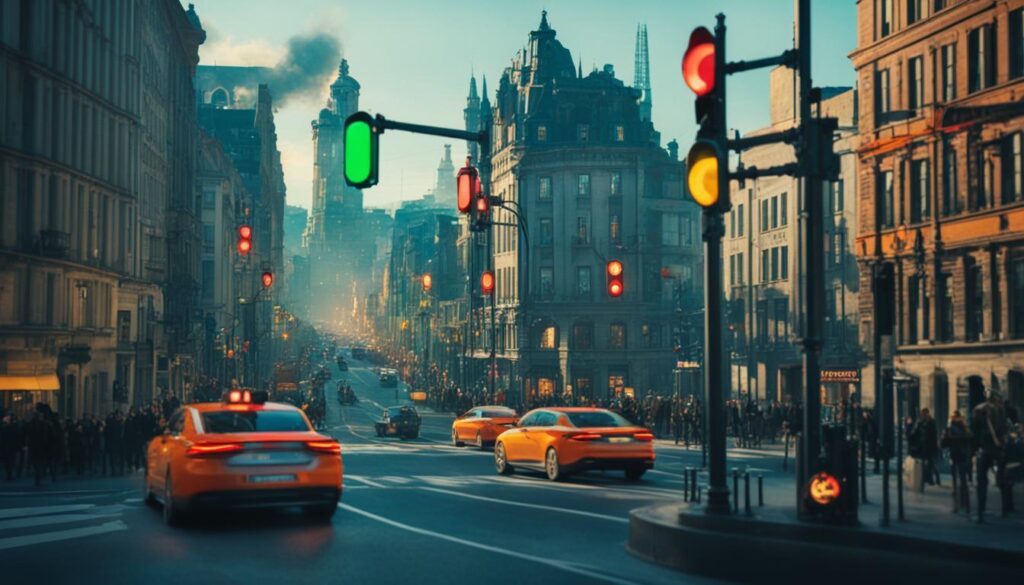In Victorian London’s busy streets, a new invention changed everything. The first traffic light, a gas-powered signal, started in December 1868 outside the British Parliament. This device was a big step towards better traffic control and sustainable cities.
John Peake Knight, a rail engineer, created this traffic light. It had two vertical arms and two gas lamps, controlled by a policeman. In the day, an upright arm meant “go,” and a horizontal arm meant “stop.” At night, green meant “go” and red meant “stop.”
This system helped with the growing traffic problems. It led to better ways to manage traffic and shaped our cities today.
Key Takeaways
- The first traffic light was installed in London in 1868
- It used gas lamps and movable arms for signaling
- Railway signals inspired its design
- A policeman manually operated the device
- It introduced color-coding for traffic control
- The invention addressed growing urban congestion
- It laid the groundwork for future traffic management systems
The Birth of Gas-Powered Traffic Lights in Victorian London
On December 9, 1868, London saw a big change in how it managed traffic. The city put its first Gas-Powered Traffic Light outside the Houses of Parliament. This new device was a big step towards making cities cleaner.
The traffic light was a wonder of Victorian engineering. It had a cast-iron column with gilding and acanthus leaves. At the top was an octagonal box with red and green gas lamps. A police officer turned the signal on and off all day, starting a new way to control traffic.
At first, the Gas-Powered Traffic Light was a hit. It aimed to organize London’s busy streets and lead to greener traffic solutions. But, its success was short-lived. In January 1869, a gas pipe burst, causing an explosion that hurt the officer badly. This led to the traffic light’s removal, leaving London without signals until 1929.
Even though it didn’t last long, this early traffic light set the stage for today’s traffic systems. It sparked ideas for greener traffic solutions and showed the need for safety in traffic control. The move from gas to electric signals would continue, changing cities for the better. Victorian London’s traffic innovation shows how bold ideas, even if they face early challenges, can lead to progress.
Evolution from Gas to Electric: A Transition in Traffic Control
In the early 1900s, traffic lights changed from gas to electric. Lester Wire, a Salt Lake City policeman, made the first electric traffic signal in 1912. This started a big change in how we manage traffic.
The American Traffic Signal Company put Wire’s design in Cleveland, Ohio. It had red and green lights and a warning buzzer.

By 1917, Salt Lake City had the first system of connected traffic signals. This was a big step towards modern traffic management. In 1920, William Potts, a Detroit police officer, created the first four-way traffic light with three colors, including amber.
In 1922, Crouse Hinds brought out automated traffic signals with timers. This cut down on the need for traffic officers and saved cities money. Now, we have Solar-Powered Signals that are good for the planet and save energy.
Today, traffic signals keep getting better. They’ve moved from gas lamps to electric and now to solar power. Each change makes cities smarter and greener. As cities get bigger, we need smart traffic management to keep them running well.
Impact and Legacy of Early Traffic Signals on Urban Planning
Traffic lights changed cities forever. They made traffic flow better and cut down on police work. The first staggered system in Washington, D.C. in 1926 doubled commute speeds, showing how effective low-emission traffic control could be.
As technology got better, so did traffic management. Denver was a pioneer in 1952 with a computer system for 120 lights. Toronto followed in 1967, controlling 159 signals over phone lines. These steps led to the energy-efficient transportation systems we use now.
Today, traffic lights are more advanced than ever. They can communicate with cars using 5G networks, making roads safer and smoother. This progress in using alternative fuel is making cities greener. From gas lamps to smart signals, traffic lights keep evolving and shaping our cities.

Leave a Reply